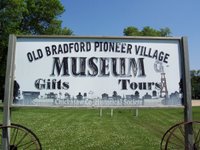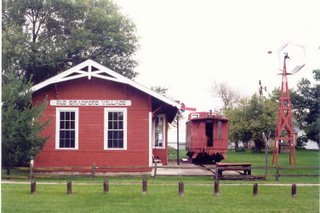Hello and Welcome to the Bradford Pioneer Village Museum in Nashua, Iowa.
We are located on highway 346 one mile east of Nashua, Iowa. We are neighbors to the world famous Little Brown Church in the Vale. We are seasonal, open from May 1 to October 31. We are open seven days a week.
In 1836 this area was an Indian trading post. Chief Bradford was the leader at that time. But as the white man moved west, these trading posts were taken over and turned into thriving towns. Thus, is the story of Bradford. As the people moved from the east coast, they were in search of land that contained everything they needed to live and sustain themselves. This area of Iowa had abundant trees and water needed to build homes, businesses, grain mills, sawmills. This area had it all. The town was called Bradford and grew to a large town of nearly 1000 people. There was a grist mill and sawmill on the Cedar River nearby. There were four hotels, general stores, blacksmith shop, school. Bradford was the County Seat. A large brick building was built that was to become one of the first academies in the State of Iowa. It was named the Bradford Acadamy and was the equivelant of a high school. Many students graduated from this academy and some returned to the east coast to go to college.
Plans were then made for the railroad to come through Bradford. Ground north of town was prepared for the forthcoming tracks. But by this time, two other towns had sprung up within the county, one being Nashua, just 1-1/2 miles to the southwest, and New Hampton, a few miles to the northeast. The railroad changed their plans and decided to run the railroad around Bradford through New Hampton and Nashua. Without the easy access to the rails, the town of Bradford began to die. And in the early 1900s had disappeared. All that remains of the original town of Bradford is the Little Brown Church. This church was made famous by the song written by William S. Pitts who was a physician and music director at the Bradford Academy. There is an interesting story about the song and when it was written, but I will leave that to another posting. The musuem and church are now part of Nashua, Iowa.
The Chickasaw County Historical Society was created in 1952-53 and the area of Bradford was designated as a museum. Many old buildings were brought in and filled with donations from people in the area. Many of the items are original Bradford. We now have 13 buildings to tour for a minimal fee of $4.00 per adult and $2.00 for children 6-12. Included in our tour is the train depot brought in from a neighboring town in the county. Changes take place in our museum all the time. Right now we are in the process of filling the large baggage area of the depot into our "transportation" room. A newly restored Henny top buggy is there and a one-horse sleigh is in the process of being restored right now that will join the buggy soon.
Outside the depot is the big red caboose. This is a favorite of school tours.
We have a log cabin that was moved from a mile south of Nashua. It belonged to a family named Smith in the 1800s. Downstairs contains the cast iron stove, table set for four, pump organ, rug weaving loom and many items that would be used daily. The upstairs contains a rope bed, a one-legged bed and a large wicker cradle with "baby" and many baby clothes from the early 1900s.
As we move on our tour we come to the original office of Dr. William S. Pitts. This wonderful building contains many of Dr. Pitts' medical supplies, medicines. His desk is there with books he used. His chair and baton are there that he used when he led the music in the Bradford Academy.
Next, we have the log cabin that houses the sewing items we have aquired. We call this cabin the Tailor Shop.
We have next the General Store. Just about anything you could possibly need would have been in the general store, clothing, shoes, dishes, toys, groceries, even the town's crank telephone.
Moving on, we have the Laundry. Washing machines that begin with the washboard and go all the way up to the Maytag wringer washer.
The Blacksmith Shop is next. The fire pit, bellows, many tools and an abundant amount of horseshoes.
Moving on, we have the Agriculture Building. A very large array of old farming tools, wagons, manuer spreader, egg incubator, and my favorite, a wheelbarrow-like grass seed planter that is over 130 years old.
After the Ag Building we walk up the hill to the Heritage Building. This building is a large country school which houses our furniture, pictures, genealogy books, a wicker wheelchair, military uniforms dating back to the Spanish-American war, a civil war drum and fife, wedding dresses, men's clothing, an old barbershop area with the utensils, including a bathtub.
From there we go to the Cottage. The cottage was built on the property after the church was built. The family of the church's caretaker lived in this house. There are many antiques that fill this home.
Then on to the New Hampton Cooler. This building has some banking items, but the thing our school tours like the best is the jail.
The Kraft School is next. This smaller country schoolhouse is set up just the way it looked when it was being used, the pull-down maps, the blackboard, desks, the pictures of Washington and Lincoln that every school room had, as well as books and flashcards.
After the school is the toy shop. A wonderful donor collected toys for many years and donated them all to our museum. Cast iron toys, wooden toys, doll buggies, tops, Jack-in-the-boxes. Kids of all ages love this part of the tour.
These are the highlites of our tour and I hope I have peaked your interest and you will want to come visit us. We have very knowledgable tour guides who can tell you stories about some of our articles and we love to listen to the stories you have as you see things on your tour that remind you of your past as well.






